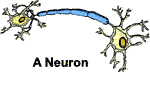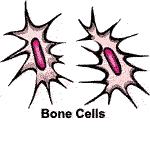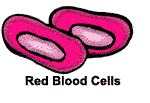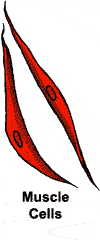Week 12 - Scientific Investigation and Medical Applications
2. Cells, Tissues, Organs and Systems
Lesson 14
No textbook readings for this lesson
Lesson 14: Cells, Tissues, Organs and Systems
Human Cells are Specialized
Cells are the basic unit of all living things. They are truly amazing. You could become a cell biologist and study your whole lifetime and still not truly understand all the functions in a single cell. Many organisms are only made as a single cell, but other organisms, like ourselves, are made of trillions of cells. A single celled organism has to do all that's necessary for life by itself, but multicellular organisms are usually made up of many kinds of specialized cells.
 |
 |
 |
 |
Tissues
When cells with single special function combine together into a tissue. Tissues are groups of similar cells that have similar structure and function to carry out a specific job. There are four main groups of Tissues:
|
Type of Tissue
|
Function
|
| Epithelium (Skin tissue) | This tissue forms glands, and covers surfaces, Your skin for example. |
| Connective Tissue | This tissue holds all the parts of your body in place. Boy, would you be a mess without this tissue! |
| Nerve Tissue | Nerve tissue (neurons) transmits messages throughout the body. |
| Muscle Tissue | Muscle tissue has only one job - it contracts (shortens) when told to do so. |
Organs
Tissues that combine together to perform a particular job are called organs . For example, the stomach contains epithelial (skin) tissue inside and out, nerve tissue and muscle tissue. It is held in place by connective tissue.
Organ Systems
Combinations of organs work together to accomplish larger tasks like digesting food (digestive system), transporting materials (circulatory system) or receiving information from the environment and deciding what to do - the nervous system. We call these combinations of organs - organ systems.
When you put all of them together the final product of all this coordination and activity is YOU!
How Marvelous.
|
© 2002 Alberta Online Consortium
|